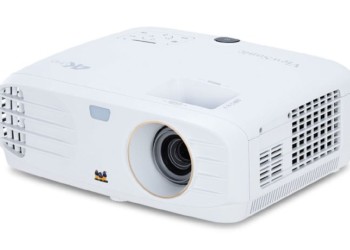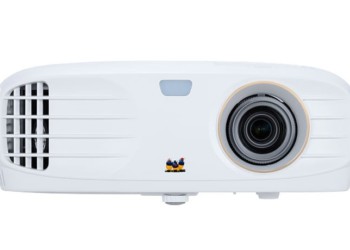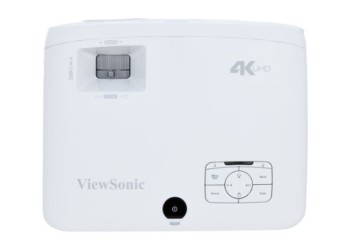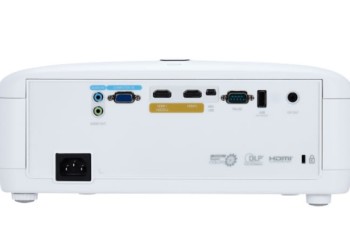Why indeed?
As a result of Delta's huge size (approaching $10 Billion US), a great many projectors come out of Delta factories, so I wasn't the least bit surprised when I opened up the Viewsonic PX727-4K and set it on my projection stand, plugged in cables, only to immediately notice that the PX727-4K, has exactly the same input and connectors on the back as does the BenQs' HT2550 and TK800 projectors, with every connector in exactly the same place on all three projectors. (They have slightly different control panels, but in the same general location, the lens is identically offset, etc.)
No surprise then, that this PX727-4K is a direct competitor to the BenQ HT2550 as both claim 2,200 lumens and sport RGBRGB color wheels. Based on viewing, I suspect they also have the same speed color wheels, as I find the rainbow effect (I am sensitive to it) to be relatively minimal compared to some other brands 4K UHD projectors we've tested including a Dell, and an Optoma.
There are other differences, however, which should let us help you figure out of the Viewsonic is the best possible choice for your specific preferences, room, etc.
While BenQ beat Viewsonic to the $1,499 price point with the first to ship of the 4K UHD projectors using 1920x1080p x 4 pixel shifting DLP chips, Viewsonic is right there with their competition also having a $1,499 list price.
The real difference is that the street price for the Viewsonic PX727-4K seems to be at $1,299, which is typically about $200 less than the BenQ and Optoma (Optoma is built by Coretronic) competition! (That at the time of this projector review being published.) Now that's definitely useful to know! Also good news for Viewsonic fans, this Viewsonic provides their typical 3 year warranty, which is longer than many 4K UHD competitors.
Perhaps most important to explain before we get into the full review and results is that these newer 1920x1080x4 DLP 4K UHD projectors are less expensive, but also slightly lower resolution than the 4K UHD DLPs that first shipped, which in turn, have the higher resolution 4K UHD DLP chip - with smaller pixels - that is 2716x1528x2). Prior to January of this year - 2018 - all shipping 4K UHD projectors used the higher res chip, and those have list prices (US$) from $2,000 on up, with those with a similar RGBRGB color wheel listing for $2,499. So, basically, you are paying an extra $1,000 for a similar projector with slightly better resolution, that is very hard to see. Also there are often other differences as well. Just remember the old saying - “There’s no such thing as a free lunch.”
This Viewsonic may not exactly rival those $2,499 and up 4K UHD projectors overall, but for not much more than half the price, you have joined the world of projectors that can accept 4K content.
It does (as a reviewer) bother me somewhat, that Viewsonic, nowhere in their user manual or data sheets (that I could find) do they mention anything about resolution other than "true 3840x2160 resolution" nor could I find mention that it is a pixel shifter!
I don't like that. This is, like all 4K UHD DLPs, is a pixel shifting projector with very large pixels compared to a true, native 4K projector. I would be happier if they were more straightforward, with something like 1920x1080x4 pixel shifting DLP chip that can put 8.3 million overlapping pixels on the screen. I imagine that if Viewsonic (like most) offered projectors with both resolution DLP chips, they would have had to specify to distinguish between the two. Ah, Marketing! Well, that's why there are reviewers - to call out manufacturers from time to time. Every manufacturer is different, but most do mention pixel shifting and some others show the native resolution (in this case 1920x1080x4).
Like most of these projectors (at least the affordable non-laser engine ones - laser 4K UHDs start at $3K list price, but are mostly $5K and up), the PX727-4K does not support the wider color space often referred to as BT.2020/P3 (P3 is the digital cinema standard). That's fine though - truth is, REC709, the standard we've had for decades, is about all that any lamp based projector can do, so trying to do P3 just doesn't really work unless you include a color filter which knocks brightness way down, something very undesirable with 4K HDR content. Always trade-offs!
The Viewsonic PX727-4K offers a 1.2:1 manual zoom lens (my assumption is it is the same lens used by the BenQ HT2550 and TK800). That's about as basic as it can get, but does allow some placement flexibility. There is built-in audio, and the provided remote control is very nice and has an excellent backlight, triggered by pressing any button (I like that). There are too many projectors under $2,000 that don't bother providing a backlit remote.

A photo of the PX727-4K projector rather nicely handling a very dynamic scene from Ghostbusters 2016. (click to enlarge)
Sorry, no lens shift to further enhance placement flexibility. Mostly, the 4K UHD projectors using the higher res DLP chip offer a very modest amount of lens shift, but so far, most of these $1,500 list price projectors do not. Also lacking on the PX727-4K, are 3D capabilities, unlike the BenQ HT2550 which supports 3D using DLP-link type 3D glasses Most of the 4K UHD projectors have skimped - that is, no 3D, so far. Most unfortunate for those of us who love the 3D experience.








